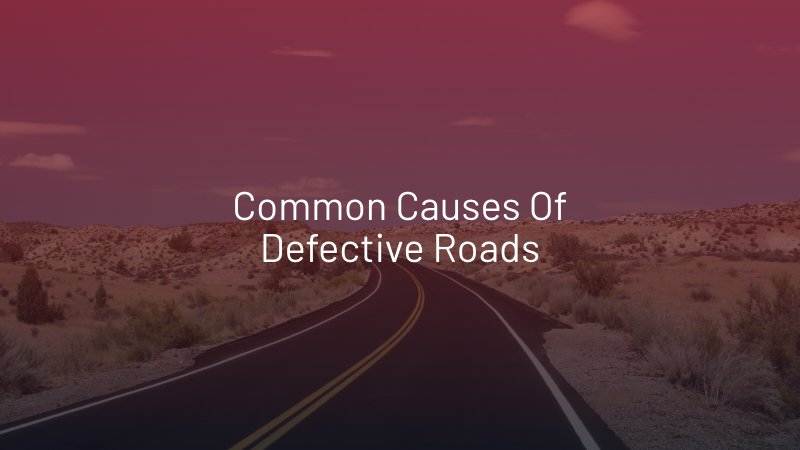Common Causes of Defective Roads
Road safety is a critical concern for drivers, cyclists, and pedestrians alike. While accidents are often attributed to driver error, defective roads can also play a significant role. Here are their most common causes.
A Las Vegas car accident lawyer can be invaluable after a crash caused by a defective road. They can help you identify liable parties, prove that the road’s condition contributed to the accident, and secure fair compensation.

Poor Road Design
One of the primary causes of defective roads is poor design. Roads must be carefully planned and engineered to accommodate the volume and type of traffic they will carry. Common design flaws include:
- Inadequate Lane Widths: Narrow lanes can make it difficult for vehicles to stay within their lanes, especially on curves or at high speeds, increasing the risk of sideswipe collisions.
- Improperly Banked Curves: On curves, the road should be banked or sloped to help vehicles maintain control. If the banking is insufficient or incorrectly angled, vehicles may lose traction, leading to accidents.
- Lack of Guardrails: Roads that run alongside steep drop-offs, rivers, or other hazards should be equipped with guardrails to prevent vehicles from leaving the roadway. A lack of these safety features can result in severe accidents.
- Confusing Intersections: Poorly designed intersections, such as those with unclear signage, sharp turns, or inadequate lighting, can lead to confusion and collisions.
Inadequate Maintenance
The Nevada Department of Transportation acknowledges that well-designed roads can become hazardous if they are not properly maintained. Over time, weather, traffic, and other factors can cause roads to deteriorate, leading to various defects:
- Potholes: Potholes are a common result of water seeping into the road surface and freezing, causing the pavement to crack and break apart. They can cause significant damage to vehicles, lead to loss of control, and increase the risk of accidents.
- Cracked and Uneven Pavement: Over time, road surfaces can develop cracks and uneven patches, creating a bumpy ride.
- Faded Road Markings: Faded or missing lane lines, crosswalks, and directional arrows can lead to confusion.
- Debris and Obstructions: Roads cluttered with debris, such as fallen branches, rocks, or discarded items, can cause drivers to swerve suddenly or lose control. Poorly placed road signs or construction equipment can also create hazardous obstructions.
When Are Road Surfaces Most Slippery?
After a dry period, rain can make roads extremely slick. This happens because oils from the asphalt rise to the surface, combined with fluids from vehicles that accumulate over time. The Federal Highway Administration estimates that every year, over 3,400 people are killed and over 357,300 people are injured in crashes during rainfall.
The asphalt contains a residue with soap-like properties that lingers on the road during rainfall. The first few minutes of rain are the most dangerous since the buildup of oils hasn’t been fully washed away.
Some specialists believe that light rain during a dry spell creates the most slippery conditions, as it takes longer for the oils to clear.
The Impact of Erosion and Weather Damage
Natural elements can significantly impact road conditions. Soil erosion caused by water runoff can undermine the stability of the roadbed, leading to sinkholes, landslides, or road collapse. Roads that are not adequately drained can become flooded during heavy rains, making them impassable and leading to hydroplaning accidents. In colder climates, roads that are not regularly plowed, salted, or treated for ice can become dangerously slippery.

Substandard Construction Materials
Low-quality asphalt or concrete can result in quicker wear and tear, leading to cracks, potholes, and surface degradation. Additionally, a weak or poorly constructed roadbed can cause the road surface to settle unevenly, leading to dips, bumps, and cracks that can disrupt vehicle control.
Lack of Proper Signage and Lighting
Road signs that are missing, damaged, or obscured by vegetation can prevent drivers from receiving crucial information, such as speed limits, warnings of sharp curves, or upcoming intersections. Poorly lit roads, especially in high-traffic areas or at intersections, increase the risk of collisions, as drivers may not see pedestrians, obstacles, or changes in road conditions until it is too late.
Contact Our Las Vegas Car Accident Lawyers Today
If you’ve been injured in an accident caused by slippery roads or other hazardous conditions, contact Harris & Harris Injury Lawyers. Their experienced team can help you understand your rights and fight for the compensation you deserve.


